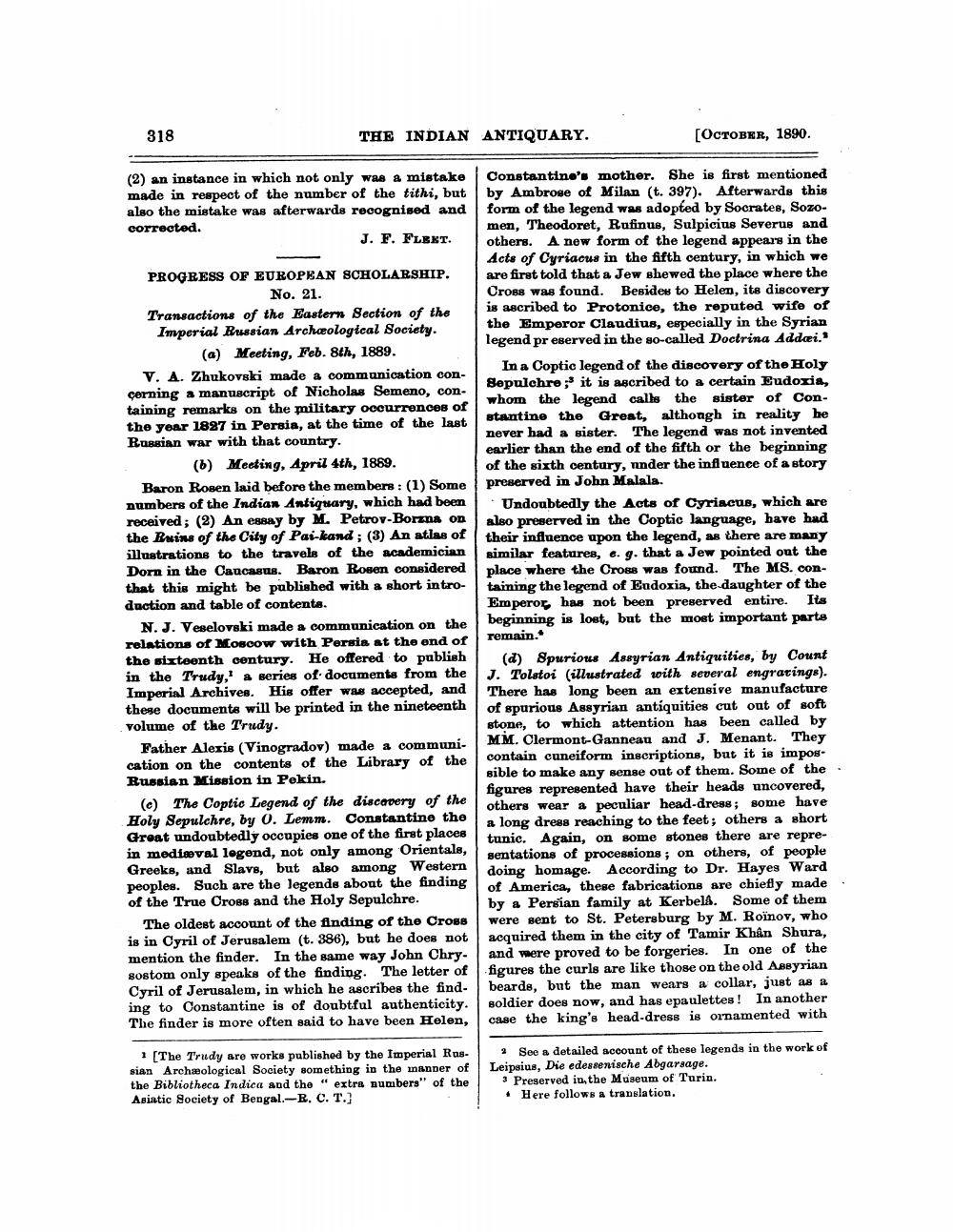________________
318
THE INDIAN ANTIQUARY.
[OCTOBER, 1890.
(2) an instance in which not only was a mistake made in respect of the number of the tithi, but also the mistake was afterwards recognised and corrected.
J. F. FLEKT.
Constantino's mother. She is first mentioned by Ambrose of Milan (t. 397). Afterwards this form of the legend was adopted by Socrates, Sozomen, Theodoret, Rufinus, Sulpicius Severus and others. A new form of the legend appears in the Acts of Cyriacus in the fifth century, in which we are first told that a Jew shewed the place where the Oross was found. Besides to Helen, its discovery is ascribed to Protonice, the reputed wife of the Emperor Claudius, especially in the Syrian legend preserved in the so-called Doctrina Addai.
In a Coptic legend of the discovery of the Holy Sepulchre ;' it is ascribed to a certain Eudoxia, whom the legend calls the sister of Constantine the Great, although in reality he never had a sister. The legend was not invented earlier than the end of the fifth or the beginning of the sixth century, under the influence of a story preserved in John Malala.
Undoubtedly the Acts of Cyriacus, which are also preserved in the Coptic language, have had their influence upon the legend, as there are many similar features, e. g. that a Jew pointed out the place where the Cross was found. The M8. CORtaining the legend of Endoxia, the daughter of the Emperor has not been preserved entire. Its beginning is lost, but the most important parts
PROGRESS OF EUROPEAN SCHOLARSHIP.
No. 21. Transactions of the Eastern Section of the Imperial Russian Archæological Society.
(a) Meeting, Feb. 8th, 1889. V. A. Zhukovski made a communication concerning a manuscript of Nicholas Semeno, containing remarks on the military occurrence of the year 1897 in Persia, at the time of the last Russian war with that country.
(6) Meeting, April 4th, 1889. Baron Rosen laid before the members: (1) Some numbers of the Indian Antiquary, which had been received; (2) An essay by M. Petrov-Borzna on the Ruins of the City of Pai-kand; (3) An atlas of illustrations to the travels of the academician Dorn in the Caucasus. Baron Roben considered that this might be published with a short introdaction and table of contenta.
N. J. Veselovski made a communication on the relations of Moscow with Persis at the end of the sixteenth century. He offered to publish in the Trudy, a series of documents from the Imperial Archives. His offer was accepted, and these documents will be printed in the nineteenth volume of the Trudy.
Father Alexis (Vinogradov) made a communi. cation on the contents of the Library of the Russian Mission in Pekin.
(c) The Coptic Legend of the discovery of the Holy Sepulchre, by 0. Lemm. Constantino the Groat undoubtedly occupies one of the first places in medieval legend, not only among Orientals, Greeks, and Slays, but also among Western peoples. Such are the legends about the finding of the True Cross and the Holy Sepulchre.
The oldest account of the finding of the Cross is in Cyril of Jerusalem (t. 386), but he does not mention the finder. In the same way John Chry- sostom only speaks of the finding. The letter of Cyril of Jerusalem, in which he ascribes the find- ing to Constantine is of doubtful authenticity. The finder is more often said to have been Helen,
(d) Spurious Assyrian Antiquities, by Count J. Tolstoi (illustrated soith several engratings). There has long been an extensive manufacture of spurious Assyrian antiquities cut out of soft stone, to which attention has been called by MM. Clermont-Ganneau and J. Menant. They contain cuneiform inscriptions, but it is impossible to make any sense out of them. Some of the figures represented have their heads uncovered, others wear a peculiar head-dress; some have a long dress reaching to the feet; others a short tunic. Again, on some stones there are representations of processions ; on others, of people doing homage. According to Dr. Hayes Ward of America, these fabrications are chiefly made by a Persian family at Kerbels. Some of them were sent to St. Petersburg by M. Rožnov, who acquired them in the city of Tamir Khan Shura, and were proved to be forgeries. In one of the figures the curls are like those on the old Assyrian beards, but the man wears a collar, just as a soldier does now, and has epaulettes! In another case the king's head-dress is ornamented with
[The Trudy are works published by the Imperial Rassian Archaeological Society something in the inander of the Bibliotheca Indica and the "extra numbers" of the Asiatic Society of Bengal.-R. C. T.]
See a detailed account of these legends in the work of Leipsius, Die edessenische Abgarsage.
Preserved in the Museum of Turin. + Here follows a translation.




